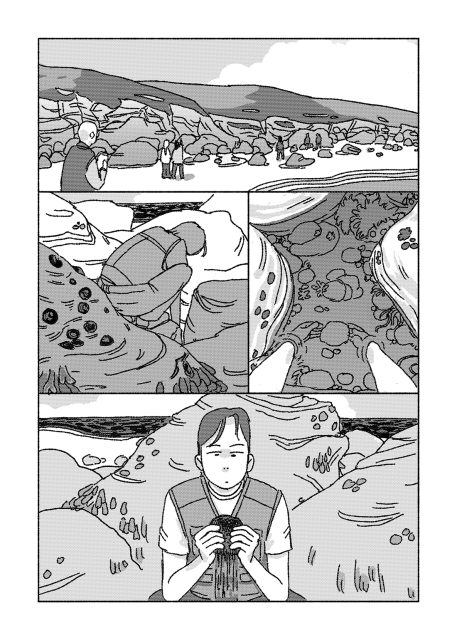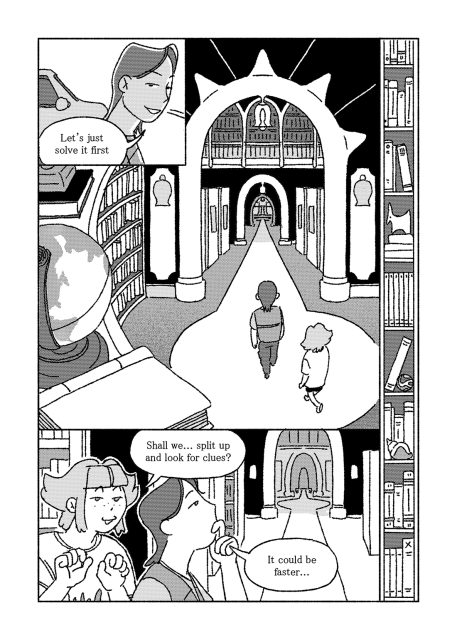In a variety of interviews, Karenza Sparks has been open about her enthusiasm for geology and stamp collecting, both of which show up significantly in her debut graphic novel. If somebody were pitching this work to Hollywood, they might describe it as Dan Brown-meets-geology. The book follows Lorelei and her friend Eddie (as well as Eddie’s cat Raisin) on a search to understand what a Corus wave is and why it might be important beyond the world of geology.
 Sparks’s story is the focus of the graphic novel, not the art, which works to convey the story, but not to impress. Her panels are black and white, serviceable enough for the action of the story and character interactions, but they’re not usually doing anything more than that. Most of the panels are close-ups of the characters talking, and, given that there is a significant amount of dialogue, their heads and faces become the focus of the art.
Sparks’s story is the focus of the graphic novel, not the art, which works to convey the story, but not to impress. Her panels are black and white, serviceable enough for the action of the story and character interactions, but they’re not usually doing anything more than that. Most of the panels are close-ups of the characters talking, and, given that there is a significant amount of dialogue, their heads and faces become the focus of the art.
If Sparks isn’t focusing on the characters, she’s centering the reader’s attention on the clues they find, leading to more close-ups of those discoveries. The artwork isn’t quite sketch-like, but it’s close, enough to give the reader the feel of an environment, but not immerse them in it. She admitted in at least one interview that her drawing improved while working on the book, which isn’t surprising, given it’s her longest comic to date. She does use more large panels with wider scope later on, but that could also be simply because the story is becoming wider in scope as the characters find what they’re looking for. Overall, the art is solid, but not the centerpiece. Instead, the plot drives things forward.
Lorelei originally finds a Palindenite when she’s an undergraduate, and that discovery leads her to write a Master’s thesis on this particular fossil. In doing research, she discovers one source that references Corus waves, but she can’t find any other mention of them. Believing she’s simply checking off one more reference in her thesis, she ends up discovering a Corus society and reaches out to them. That visit leads her and Eddie from one structure the fictional thinker Havius Corus built to another, each one providing them with an additional clue.
Havius Corus has developed a theory about Corus waves, which makes him a pariah in scientific circles. He often mentions hearing the voices of angels, a decidedly non-scientific approach to fossils, for example. He destroyed all of his work, though he continued to believe in it until he disappeared. For a while, he focused on architecture, but then he simply left the country, it appears.
As in a Dan Brown novel (or a movie adaptation of his work), Lorelei and Eddie discover information in odd places — on the backs of bricks, as well as hidden tunnels. Sparks even references Brown in her work, as she’s aware that she’s playing on a trope that Brown popularized. However, Sparks’ work is much more lighthearted, minus the conspiracy theories, and she focuses much more on celebrating geology than on pointing out any secret cults.

That said, she does remind readers that science is not always welcoming of ideas that don’t fit within its established worldview, something Eddie reminds Lorelei about. There’s a moment where they find a tuning fork that rings out loudly throughout the building where they’ve discovered it, and Eddie admits that she feels some sort of mystical connection to Lorelei. But Lorelei, with her scientific approach, is unable to accept that there could be something inexplicable about the resonance or the fossil. More and more evidence begins to build, though, that shows Eddie is more correct than she knows.
 This idea of connection runs throughout the work and is one of Sparks’ major themes, both in terms of humanity’s ties to nature and to one another. When Lorelei discovers how the Corus waves work, she begins to understand how the animals that are now fossils could have survived, despite their small size. Sparks builds on the growing field of science that centers around how supposedly non-sentient plants have a means of communication that humanity has long ignored. Lorelei realizes that it’s not that these plants couldn’t have communicated; it’s just that humanity hasn’t understood how until she makes her discovery.
This idea of connection runs throughout the work and is one of Sparks’ major themes, both in terms of humanity’s ties to nature and to one another. When Lorelei discovers how the Corus waves work, she begins to understand how the animals that are now fossils could have survived, despite their small size. Sparks builds on the growing field of science that centers around how supposedly non-sentient plants have a means of communication that humanity has long ignored. Lorelei realizes that it’s not that these plants couldn’t have communicated; it’s just that humanity hasn’t understood how until she makes her discovery.
Similarly, when Lorelei and Eddie discover some writings by Corus, they see that he has made a similar realization, though his insight relates as much to people as it does to nature. He writes, “I knew I needed other minds at work, and they would not come to me.” It’s only once one scientist has the courage to befriend Corus and work with him that he is able to succeed, even if he cannot publish his findings. The working relationship Corus develops parallels Eddie and Lorelei’s friendship (Eddie is often the one to discover a clue, which Lorelei can then interpret). Even before they leave to do research, Eddie brings Lorelei food, as she often forgets to eat — it reinforces this idea of community and relationship as a vital part in discovery.
Ultimately, The Corus Wave is an expression of an author’s love of geology, which she uses to celebrate the importance of strong relationships — particularly the female friendship at the core of this work — and community. There aren’t any grand conspiracies here, just the narrow-minded views of those who would limit science or nature to only what humans can understand.
The post The Corus Wave appeared first on The Comics Journal.

No comments:
Post a Comment